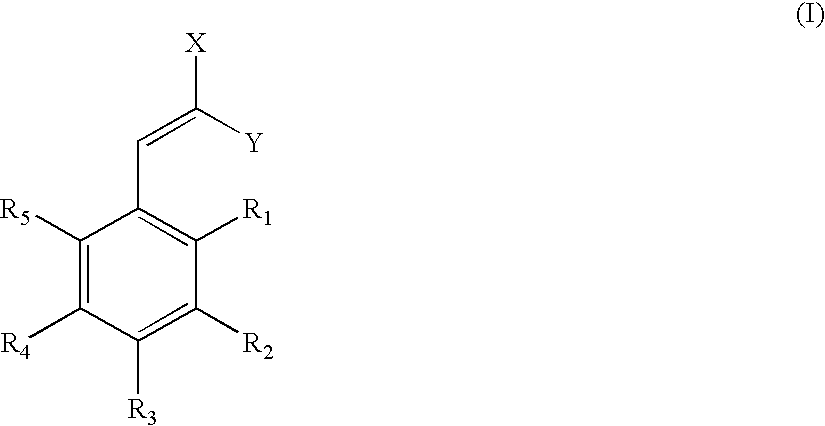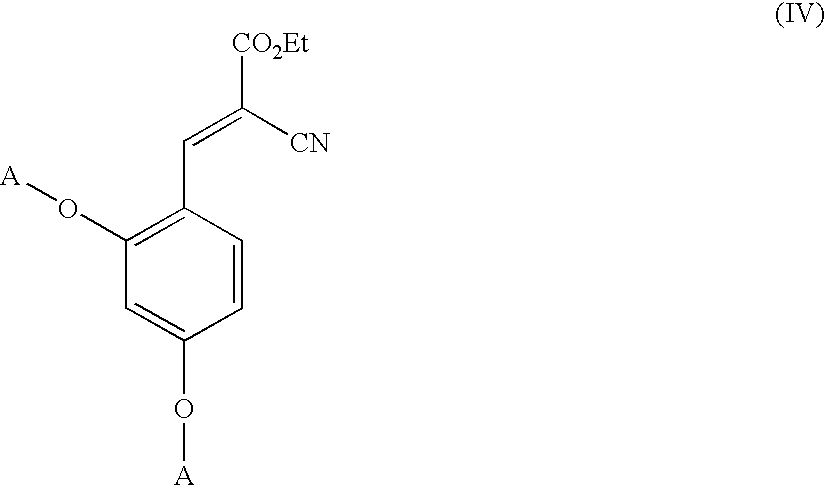Low-color ultraviolet absorber compounds and compositions thereof
a technology of ultraviolet absorber and compound, applied in the field of low-color ultraviolet absorber compound and composition, can solve the problems of difficult incorporation within different target media, relatively low melting point, and potentially damaging range of unprotected ultraviolet exposure, and achieve the effect of brighter clarity
- Summary
- Abstract
- Description
- Claims
- Application Information
AI Technical Summary
Benefits of technology
Problems solved by technology
Method used
Image
Examples
example 1
Two thousand two hundred and eighty grams of vanillin, 20 g of lanthanum phosphate catalyst were charged to an autoclave. The autoclave was then sealed, purged several times with nitrogen gas (to a pressure of 60 PSIG) and then pressurized to 5 PSIG of nitrogen. After heating the autoclave to 121.degree. C., ethylene oxide was added to the reaction mixture until a total of 3960 g were added over time. Once all of the ethylene oxide was added, the mixture was post-cooked for a total of thirty minutes. The mixture was then cooled to 93.degree. C. and stripped at reduced pressure for fifteen minutes in order to remove un-reacted ethylene oxide. The product is a pale yellow liquid with a hydroxyl number of 134.
Nine hundred and thirty eight grams of 4-polyoxyalkylene-3-methoxy-benzaldehyde from the reaction described above, 30 g of Vitamin E, 8 g of glycine, 150 g of water and 305 g of ethyl cyanoacetate were charged to a 5 liter three neck round bottom flask. In the presence of a nitrog...
example 2
Four hundred and fifty-six grams of vanillin, one gram of KOH flake and four grams of proton sponge [1,8-bis(dimethylamino)naphthalene] were charged to an autoclave. The autoclave was then sealed, purged several times with nitrogen gas (to a pressure of 60 PSIG) and then pressurized to 5 PSIG of nitrogen. After heating the autoclave to 121.degree. C., ethylene oxide was added to the reaction mixture until a total of 792 g were added over time. Once all of the ethylene oxide was added, the mixture was post-cooked for a total of thirty minutes. The mixture was then cooled to 93.degree. C. and stripped at reduced pressure for fifteen minutes in order to remove un-reacted ethylene oxide. One thousand two hundred and fifty-three grams of product (yield 97%) is obtained as a pale yellow liquid with a hydroxyl number of 142.
100.4 grams of 4-polyoxyalkylene-3-methoxy-benzaldehyde from the reaction described above, 0.82 g of Vitamin E, 0.92 g of glycine, 20 g of water and 26.3 g of ethyl cya...
example 3
One thousand eight hundred and thirty grams of 4-hydroxybenzaldehyde, 20 g of lanthanum phosphate catalyst (as used above in EXAMPLE 1) were charged to an autoclave. The autoclave was then sealed, purged several times with nitrogen gas (to a pressure of 60 PSIG) and then pressurized to 5 PSIG of nitrogen. After heating the autoclave to 121.degree. C., ethylene oxide was added to the reaction mixture until a total of 3960 g were added over time. Once all of the ethylene oxide was added, the mixture was post-cooked for a total of thirty minutes. The mixture was then cooled to 93.degree. C. and vacuum stripped for fifteen minutes in order to remove unreacted ethylene oxide. The product is a pale yellow liquid with a hydroxyl number of 144.
Eight hundred sixty grams of 4-polyoxyalkylene-benzaldehyde from the reaction described above, 30 g of Vitamin E, 8 g of glycine, 150 g of water and 305 g of ethyl cyanoacetate were charged to a 5 liter three neck round bottom flask. In the presence o...
PUM
| Property | Measurement | Unit |
|---|---|---|
| wavelengths | aaaaa | aaaaa |
| wavelengths | aaaaa | aaaaa |
| wavelengths | aaaaa | aaaaa |
Abstract
Description
Claims
Application Information
 Login to View More
Login to View More - R&D
- Intellectual Property
- Life Sciences
- Materials
- Tech Scout
- Unparalleled Data Quality
- Higher Quality Content
- 60% Fewer Hallucinations
Browse by: Latest US Patents, China's latest patents, Technical Efficacy Thesaurus, Application Domain, Technology Topic, Popular Technical Reports.
© 2025 PatSnap. All rights reserved.Legal|Privacy policy|Modern Slavery Act Transparency Statement|Sitemap|About US| Contact US: help@patsnap.com



